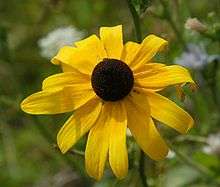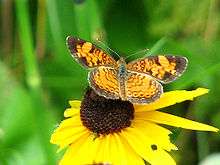Rudbeckia hirta
| Rudbeckia hirta | |
|---|---|
 | |
| Rudbeckia hirta flowerhead | |
| Scientific classification | |
| Kingdom: | Plantae |
| (unranked): | Angiosperms |
| (unranked): | Eudicots |
| (unranked): | Asterids |
| Order: | Asterales |
| Family: | Asteraceae |
| Genus: | Rudbeckia |
| Species: | R. hirta |
| Binomial name | |
| Rudbeckia hirta L. | |
| Synonyms[1] | |
|
Synonymy
| |
Rudbeckia hirta, commonly called black-eyed-Susan, is a North American species of flowering plants in the sunflower family, native to the Eastern and Central North America and naturalized in the Western part of the continent as well as in China. It has now been found in all 10 Canadian Provinces and all 48 of the states in the contiguous United States.[2][3][4]
Rudbeckia hirta is one of a number of plants with the common name black-eyed Susan. Other common names for this plant include: brown-eyed Susan, brown betty, gloriosa daisy, golden Jerusalem,[5][6] English bull's eye, poor-land daisy, yellow daisy, and yellow ox-eye daisy.[7]
Rudbeckia hirta is the state flower of Maryland.[8]
The plant also is a traditional Native American medicinal herb in several tribal nations;[9] believed in those cultures to be a remedy, among other things, for colds, flu, infection, swelling and (topically, by poultice) for snake bite (although not all parts of the plant are edible)[9]
Parts of the plant have nutritional value. Other parts are not edible.
Description
Rudbeckia hirta is an upright annual (sometimes biennial or perennial) growing 30–100 cm (12–39 in) tall by 30–45 cm (12–18 in) wide. It has alternate, mostly basal leaves 10–18 cm long, covered by coarse hair, with stout branching stems and daisy-like, composite flower heads appearing in late summer and early autumn. In the species, the flowers are up to 10 cm (4 in) in diameter, with yellow ray florets circling conspicuous brown or black, dome-shaped cone of many small disc florets.[10] However, extensive breeding has produced a range of sizes and colours, including oranges, reds and browns.[3][11]
Etymology
The genus name honors Olaus Rudbeck, who was a professor of botany at the University of Uppsala in Sweden and was one of Linnaeus's teachers. The specific epithet refers to the trichomes (hairs) occurring on leaves and stems.[12]
Varieties
There are four varieties[1][3]
- Rudbeckia hirta var. angustifolia - southeastern + south-central United States (South Carolina to Texas)
- Rudbeckia hirta var. floridana - Florida
- Rudbeckia hirta var. hirta - Eastern United States (Maine to Alabama).
- Rudbeckia hirta var. pulcherrima. Widespread in most of North America (Newfoundland to British Columbia, south to Alabama and New Mexico; naturalized Washington to California).
Cultivation
Rudbeckia hirta is widely cultivated in parks and gardens, for summer bedding schemes, borders, containers, wildflower gardens, prairie-style plantings and cut flowers. Numerous cultivars have been developed, of which 'Indian Summer'[13] and 'Toto'[14] have gained the Royal Horticultural Society's Award of Garden Merit. Other popular cultivars include 'Double Gold' and 'Marmalade'.
Gloriosa daisies are tetraploid cultivars having much larger flower heads than the wild species, often doubled or with contrasting markings on the ray florets. They were first bred by Alfred Blakeslee of Smith College by applying colchicine to R. hirta seeds; Blakeslee's stock was further developed by W. Atlee Burpee and introduced to commerce at the 1957 Philadelphia Flower Show.[15] Gloriosa daisies are generally treated as annuals or short-lived perennials and are typically grown from seed, though there are some named cultivars.
Symbolism and uses
Maryland state flower
- The black-eyed Susan was designated the state flower of Maryland in 1918.[8][16] In this capacity it is used in gardens and ceremonies to celebrate, memorialize and show affection for the state of Maryland and its people.
- The Preakness Stakes in Baltimore, Maryland, has been termed "The Run for the Black-Eyed Susans" because a blanket of Viking Poms, a variety of Chrysanthemums resembling Black-eyed Susans, is traditionally placed around the winning horse's neck (actual Black-eyed Susans are not in bloom in May during the Preakness).[17]
Symbol of Justice
The black-eyed Susan which also traditionally symbolizes “Justice” makes a very nice cut-flower with a vase life up to 10 days.[18]
University of Southern Mississippi
In 1912, the black-eyed Susan became the inspiration for the University of Southern Mississippi school colors (black and gold), suggested by Florence Burrow Pope, a member of the university's first graduating class. According to Pope: “On a trip home, I saw great masses of Black-Eyed Susans in the pine forests. I decided to encourage my senior class to gather Black-Eyed Susans to spell out the name of the class on sheets to be displayed during exercises on Class Day. I then suggested black and gold as class colors, and my suggestion was adopted."[19]
Butterfly attractant for enhancing gardens
- Butterflies are attracted to Rudbeckia hirta when planted in large color-masses, creating a beautiful spectacle.[20]
Traditional Native American medicinal uses
- The roots but not the seedheads of Rudbeckia hirta can be used much like the related Echinacea purpurea to boost immunity and fight colds, flu and infections.
- It is also an astringent when used in a warm infusion as a wash for sores and swellings.
- The Ojibwa people used it as a poultice for snake bites[21] and to make an infusion for treating colds and worms in children.
- The plant is also diuretic and was used by the Menominee and Potawatomi peoples.
Juice from the roots has been used as drops for earaches.[9]
Nutritional parts
- Certain parts of the plant contains anthocyanins[22] a class of antioxidant with several known health benefits.
Cautions
- As with any wild plant, it is usually recommended to research carefully before consuming as not all parts of the plant may be edible and to avoid mis-identification with other plants that may look similar to the Black eyed Susan.
- It is widely recommended always to consult one's doctor before taking any medicinal herb.
- With any herb approved by a doctor for use, it is widely agreed that recommended dosages and preparation procedures should always be followed.
- The species is also known to be toxic to cats when ingested.[23]
Gallery

- Rudbeckia hirta 'Indian summer'
- Rudbeckia hirta 'Indian summer'
 Rudbeckia hirta in southern Maine
Rudbeckia hirta in southern Maine- Rudbeckia hirta

References
- 1 2 The Plant List, Rudbeckia hirta L.
- ↑ Biota of North America Program 2014 county distribution map
- 1 2 3 Flora of North America, Black-eyed Susan, Rudbeckia hirta Linnaeus, Sp. Pl. 2: 907. 1753.
- ↑ Flora of China, 黑心菊 hei xin ju, Rudbeckia hirta Linnaeus
- ↑ Dolgopolov, Y. (2004). A collection of confusable phrases: False 'friends' and 'enemies' in idioms and collocations. Coral Springs, FL: Llumina Press.
- ↑ http://www.collinsdictionary.com/dictionary/english/niggerhead
- ↑ Runkel, Sylvan T.; Roosa, Dean M. (1989). Wildflowers of the Tallgrass Prairie: The Upper Midwest. Ames, IA: Iowa State University Press.
- 1 2 3 4 "MARYLAND AT A GLANCE: STATE SYMBOLS, Maryland State Flower - Black-Eyed Susan", Maryland State Archives, Maryland Manual Online
- 1 2 3 Moerman. D. (1998). Native American Ethnobotany. Timber Press. Oregon. ISBN 0-88192-453-9.
- ↑ Floridata: Rudbeckia hirta.
- ↑ RHS A-Z encyclopedia of garden plants. United Kingdom: Dorling Kindersley. 2008. p. 1136. ISBN 1405332964.
- ↑ Andy's Northern Ontario Wildflowers: Native Meadow Wildflowers. Black-eyed Susan.
- ↑ "RHS Plant Selector - Rudbeckia hirta 'Indian Summer'". Retrieved 2 June 2013.
- ↑ "RHS Plant Selector - Rudbeckia hirta 'Toto'". Retrieved 2 June 2013.
- ↑ Lacy, Allen (July 21, 1988). "Gloriosa, the Eliza Doolittle of Daisies". New York Times. Retrieved 2013-10-22.
- ↑ "Fiscal and Policy Notes (HB 345)" (PDF). Department of Legislative Services - Maryland General Assembly. 2010. Retrieved 2010-03-13.
- ↑ Reimer, Susan. "Neither Susans nor daisies", Baltimore Sun. May 16, 2014
- ↑ "Black Eyes Susan Wildflower".
- ↑ The Drawl: The History and Traditions of the University of Southern Mississippi (PDF) (Centennial ed.). The University of Southern Mississippi. 2010. p. 10. Retrieved 5 September 2015.
- ↑ Schillo, Rebecca (2011). Cummings, Nina, ed. "Native Landscaping Takes Root in Chicago". In The Field: 13.
- ↑ Brandeis University, Black-Eyed Susan (Rudbeckia hirta)
- ↑ Refdoc, Luczkiewz M., & Cisowski W. (2001). Optimisation of the second phase of a two phase growth system for anthocyanin accumulation in callus cultures of Rudbeckia hirta. Plant cell, tissue and organ culture 65: 57-68
- ↑ "List of plants toxic to cats".
External links
| Wikimedia Commons has media related to Rudbeckia hirta. |
| Wikispecies has information related to: Rudbeckia hirta |
| Wikiversity has bloom time data for Rudbeckia hirta on the Bloom Clock |
- "Rudbeckia hirta". The Global Compositae Checklist (GCC) – via The Plant List.
- Lake Country, A Tale of Two Susans non-scholarly essay on the etymology and history
- Knowlton Foote. 2001. Black-eyed Susan (Rudbeckia hirta L.). New York Flora Association. Newsletter Vol. 13.